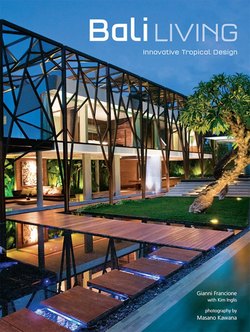Читать книгу Bali Living - Gianni Francione - Страница 8
На сайте Литреса книга снята с продажи.
ОглавлениеAt the entrance to the Emerald Estates, built for a French owner, Eric Lorin, and completed in 2005, all is calm, orderly and cool. The estate contains two villas; this building is the living pavilion of the one known as Emerald Sunset.
Emerald Sunset is built in a u-shape: On the left is the modern living pavilion; at centre and right are two more traditional structures with wood shingled roofs. The smaller central one houses a dining area and the one on right the bedrooms.
Located in a compound in Canggu, these two villas are ideally situated close to the beach in a beautiful Balinese garden with mature trees and plantings. Although totally different in layout, design and atmosphere, they share a common architectural language, exemplified by the extensive use of old ironwood electricity poles as a structural and aesthetic element and the correspondence between the architecture and its surrounding landscape. Both villas take full advantage of the serene surrounds in which they find themselves.
Designed by Indonesian architect Yoka Sara of the firm Bale Legend, the villas employ both modern and traditional elements. Sara was aiming at a balanced composition, and this he has achieved with a strong interplay between curved and straight, horizontal and vertical, heavy and light. Named Emerald Sunset and Emerald River for obvious reasons, both villas are impressive additions to the Bali holiday rental scene.
Emerald Sunset is composed of three two-storey buildings linked by a second-floor terrace, which has fabulous sundowner views over the sea. The main volume sports a fresh architectural composition: old electricity poles and hollow steel beams form the basic structure which houses a downstairs living area and an upper relaxing corner. A slim curved metallic roof is the most eye-catching feature: it both insulates the building and seems to soar above it giving a general sense of agility and lightness.
This contrasts, yet complements, the other two structures that are rather more vernacular in form: an open dining pavilion and a building that houses the bedrooms. The latter is noteworthy for its use of double-height ironwood poles that support the roof and, in some cases, plunge down into the 20-metre-long (56 feet) curved swimming pool that hugs the side of the building. The pool is composed of lava stone and Indian slate tiles that change colour from emerald to sky blue depending on the time of day and the weather.
Emerald River, the second villa, is more traditional architecturally but is nonetheless stunning mainly because of the way its buildings have been incorporated around an “island” of mature trees and vegetation. Comprising four different two-storey buildings, linked on the second floor by a large terrace and connecting “bridges”, it sports a curved pool with a dramatic concave overflow, attendant sinuous pavilion-style living and dining spaces and—again—the use of structural ironwood supports.
There is no doubt that guests are spoilt for choice as regards key locations in both villas: Where to lounge? A poolside pebble-washed terrace, an open-plan living room overlooking garden and rice field or a 25-sq-m Jacuzzi? What better dilemma to have when on holiday?
A double-storey pavilion with dramatic roof sits behind one of the garages at the entrance. The garage, marked by a decorative wooden grille on the curved wall and an inclined flying cover of metal, wood and plastic sheeting that plays with the bigger curved roofing above, is almost like an installation. The small planter box on left gives balance to the whole composition. The pavilion, itself, houses a downstairs living room and an upper relaxing area; built from ironwood poles and hollow steel beams with copious amounts of glass, its most striking feature is its slim curved metallic roof.
The building that houses the bedrooms is hugged by a gently curving swimming pool that runs the length of the villa. The ironwood poles play both an architectural role (supporting the roof) and also freely interplay with the pool and deck below.
An airy, open corridor leads to the entrance of Emerald River villa. A sequence of inclined wooden struts on metal supports carries a horizontal wood and metal ceiling; the poles dot the patterned pebble-washed floor and give character to the whole. A decorative Buddha-head painting at the far end gives a focal point to the gallery-style structure.
Water is a unifying and almost architectural element in the Emerald Estates. Here, the pool curves round the open-air dining pavilion and lounging deck, both simply furnished with items that weather well.
A swirling pebblewashed floor joins the entranceway with a living area that is arranged around a wonderful curved swimming pool. Casual, comfy modular furniture pieces in wood and rattan weave afford great views over the garden. A glass plate by Seiki Torige sits on one of the coffee tables.
The dramatic curved swimming pool of Emerald River divides the living pavilion from the more traditionally-inspired dining pavilion on the right. The two are connected by an overwater bridge and unified by prolific vegetation and the beautiful silhouette of a single palm tree rising out from the water.
An all-wood rectangular pavilion houses the master bedroom and bathroom in Emerald River. Here, the décor is dominated by the colour red, with soft drapes, throws and cushions in scarlet silk and cotton.
The curved pool as seen during the daylight.
A relaxing area on the first floor of the modernistic steel, glass and wooden pavilion has an airy, light feeling and almost 360-degree views out to the surrounding garden.
Night time bathing beneath the stars is one of the tropical dream seeker’s secret indulgences. Here, the refined shape of an open-to-the-air bathtub cast in ivory terrazzo floats on a lawn of white pebble-washed concrete; it is surrounded by a textured slatted wooden screen. Terrazzo sinks for him and her are set adjacent in a covered section.
